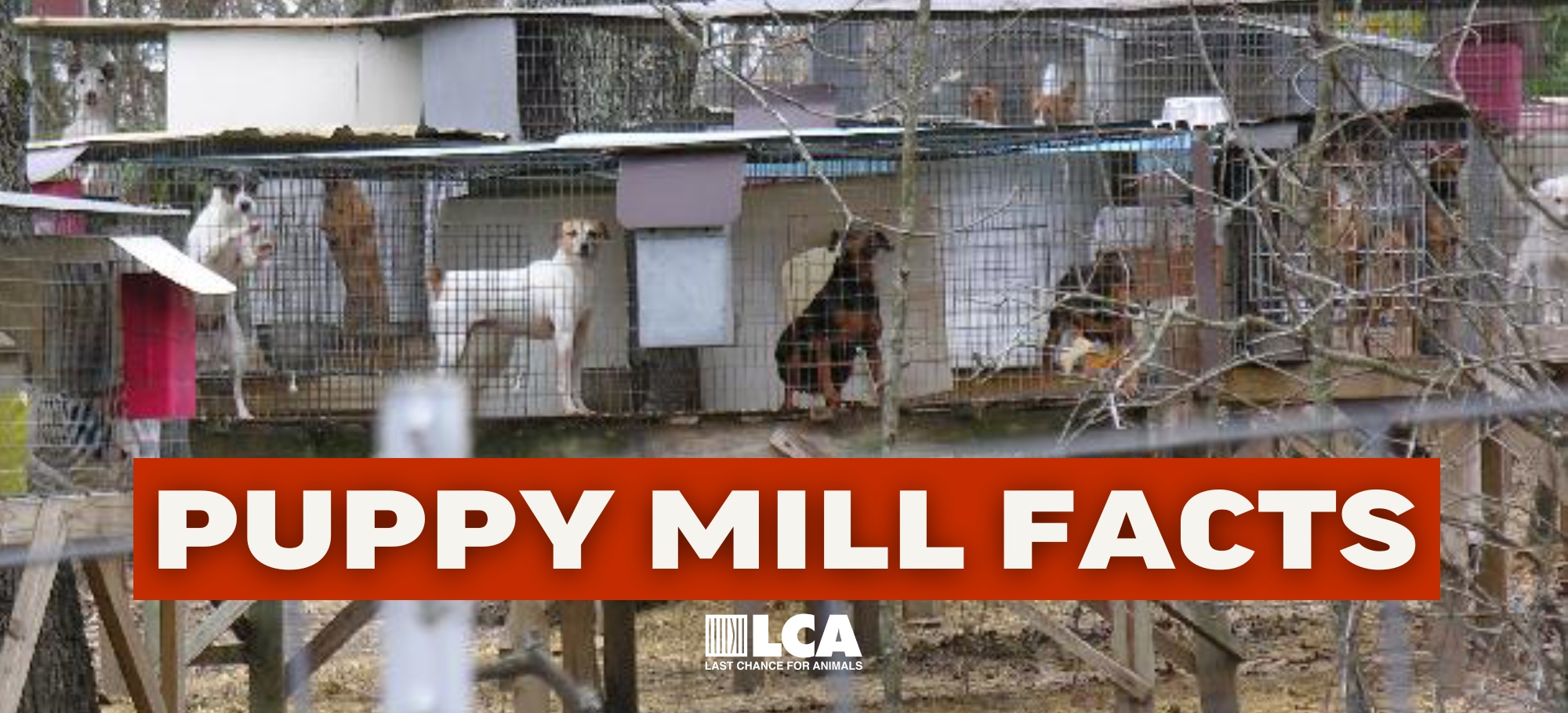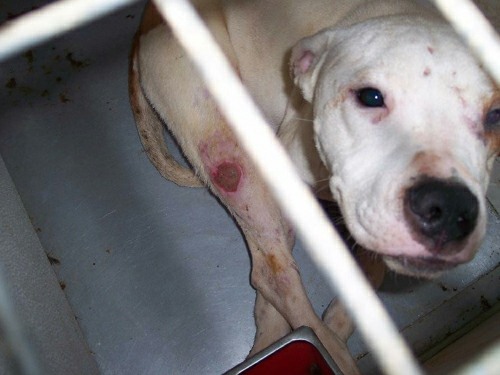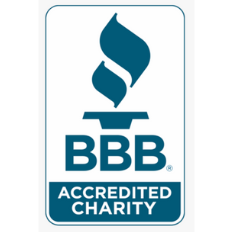PUPPY MILL FACTS
WHAT IS A PUPPY MILL?
A puppy mill is a mass breeding facility that produces puppies for sale. According to the latest data, there are almost 10,000 active puppy mills in the United States, producing over 2 million puppies per year. These facilities, most of which are inspected and licensed by the U.S.D.A., are notorious for their filthy, overcrowded conditions, and the unhealthy animals they produce. Many of the dogs suffer from malnutrition and exposure, usually remaining outside year round, enduring both freezing temperatures in the winter and intense heat in the summer. Cat breeding occurs on a smaller scale and under similar conditions.
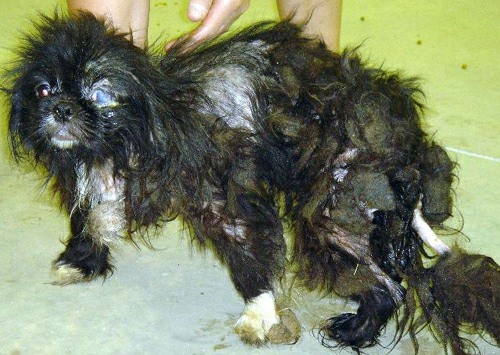
Rescued puppy mill dog suffering from a severe case of untreated mange and a ruptured eye
PUPPY MILL CONDITIONS
Puppy mill kennels generally consist of small, outdoor wood and wire cages or crates. The animals are crammed into these filthy cages. Their eyes are filled with pus and their fur with excrement. Many of the puppies suffer from malnutrition and exposure. Like pet store owners, breeders save money, and thus maximize profits, by spending little on food, shelter, and veterinary care. Puppies consequently receive below standard food, minimal if any veterinary care, and inadequate shelter which, combined with the inbreeding prevalent in puppy mills, produce animals with genetic diseases and abnormalities. Puppies’ legs often fall through the bottom of their wire cages, causing additional injuries.
|
The hind leg of this mill dog was eaten off by another dog. She lay for two days without medical attention, even though the puppy miller was aware of her condition. She died shortly after rescue.
This mill dog’s body is covered with sores. Her cage barely allows room to turn around. |
“BROOD BITCHES”
Female dogs kept in puppy mills their entire lives are called “brood bitches.” They are typically undernourished and receive little veterinary care, in spite of being kept perpetually pregnant. Their puppies are frequently taken from them before being weaned. As a result, some puppies do not know how to eat and thus die of starvation. At approximately six or seven years of age, when they can no longer breed more puppies, “brood bitches” are killed.
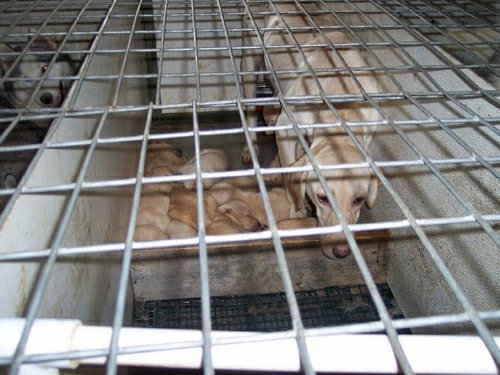
“
TRANSPORTATION AND SALE
At four to eight weeks of age, puppies are taken from their mothers and sold to brokers (or retail businesses). The brokers then pack them in crates and transport them for sale at various pet shops. Frequently, the puppies are not provided with adequate food, water, ventilation, or shelter during transport; consequently, many die en route. Those that are not sold will be killed, brought back to the mill to breed, or sold to laboratories for research.
U.S. - THE ANIMAL WELFARE ACT
Puppy mills are regulated by the US Department of Agriculture, under the Animal Welfare Act, which, passed by Congress in 1966, established minimum standards of care for animals bred for commercial sale. It is estimated that there are more than 5000 licensed puppy mills currently breeding and selling animals commercially in the US. These licensed mills provide local pets stores with an estimated 500,000 puppies and kittens each year. However, there are thousands more breeding facilities with equally horrific conditions which remain unlicensed and unregulated because they sell dogs online or directly to the public.
Inspectors for the Animal and Plant Health Inspection Services (APHIS), under the USDA, are charged with inspecting and regulating thousands of puppy mills, as well as research facilities, zoos, and circuses each year. Understaffed and with authority limited to an inadequate Animal Welfare Act, kennels are inconsistently inspected and anti-cruelty laws are rarely enforced in the rural areas where most puppy mills are located. Even when licensed breeders are found to be in violation of AWA, puppy mill operators are allowed to remain open while they remedy them. Repeat offenders often refuse to allow Animal and Plant Health Inspection Service workers to enter and inspect their facilities; these kennels sometimes remain licensed in spite of this noncompliance.
The Animal Welfare Act (AWA) falls far short of what most individuals would consider minimum standards of care, and this is acknowledged in the USDA’s own materials.
“Individuals who operate facilities in these categories must provide
their animals with adequate care and treatment in the areas of housing,
handling, sanitation, nutrition, water, veterinary care, and protection
from extreme weather and temperatures. Although Federal requirements
establish acceptable standards, they are not ideal.
Regulated businesses are encouraged to exceed the specified minimum standards.”
*Source, APHIS AWA Factsheet
VICTORY! CALIFORNIA BANS THE SALE OF MILL ANIMALS IN PET STORES
On October 13, 2017, Governor Jerry Brown signed California A.B. 485: the Pet Rescue and Adoption Act into law, banning the retail sale of commercially bred dogs, cats, and rabbits in pet shops across the state. The law went into effect on January 1, 2019, and requires all California pet stores to only sell dogs, cats, and rabbits obtained from local pet shelters, humane societies, and rescues. California is the first state in the nation to pass such legislation, which aims to stop neglectful animal breeders from profiting off of the sale of dogs, cats, and rabbits in order to give California's homeless pets a greater chance of finding a home.
Many cities, counties, and townships have passed so-called “pet store bans,” local ordinances prohibiting the retail sale of commercially bred dogs. Currently, over 230 of these ordinances have been passed and more localities are enacting similar bans at an increasing rate.
THE AMERICAN KENNEL CLUB
Although the AKC claims to be devoted to advancing the health of purebred dogs, it typically spends only about 2% of its total yearly income on research towards that end. Moreover, AKC papers do not guarantee the value or health of a puppy. The organization does not try to work with breeders to improve mill conditions, perhaps because breeders pay the AKC millions.
LEARN MORE ABOUT PUPPY MILL AWARENESS DAY

